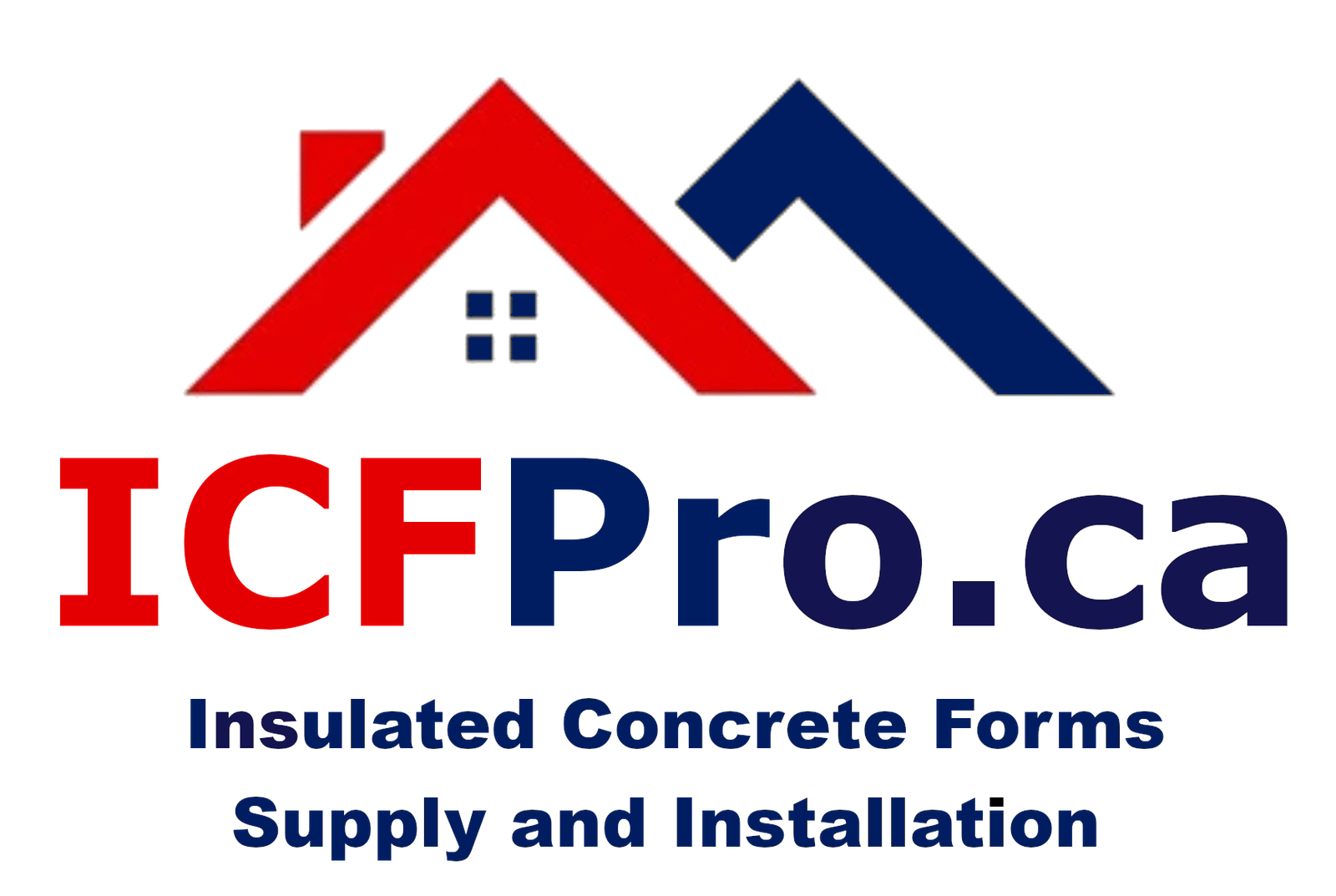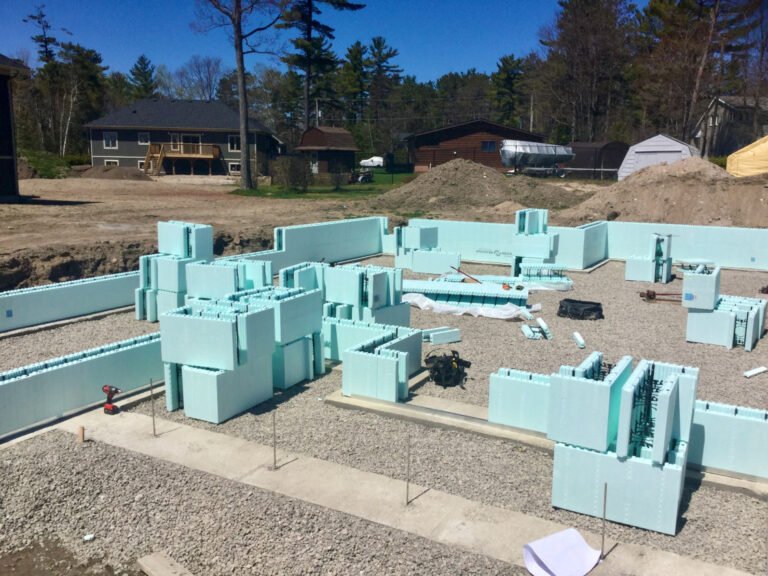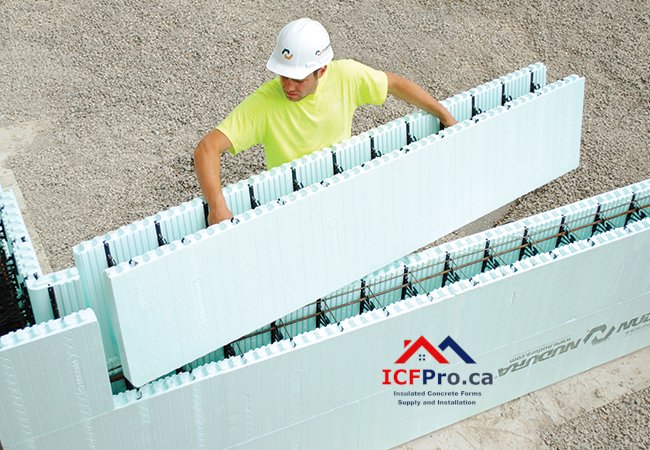ICFPro.ca is a division of ICFhome.ca - Phone 1 866 868-6606 - Direct Line 1 705 533-1633 - Email: info@icfhome.ca
The World of ICF – Insulated Concrete Forms Manufacturers

Jumpin’ into the quirky universe of Insulated Concrete Forms (ICF), it’s key to get a handle on the ICF basics. Born in Belgium way back in 1937, ICFs shook up the construction scene with their clever mix of concrete walls hugged by two layers of insulation. Today’s ICF setups don’t just meet the ASHRAE/ANSI 90.1 energy code rules; they smash ’em, proving unbeatable in energy efficiency for building projects (Fox Blocks).
ICF vs. CMU Comparison
In the comic smackdown between Insulated Concrete Forms and Concrete Masonry Units (CMUs), it’s like CMUs are still rockin’ bell bottoms in the age of skinny jeans. ICFs, meanwhile, stride in like the superhero—faster, stronger, and just outright cooler. When it comes to speed, less labor, and plain old ease, ICFs leave CMUs in the dust. Plus, they nail it on durability, energy savings, and keeping indoor air quality fresh (Fox Blocks).
Grasp these straightforward differences and hilarious comparisons, and you’ll be skipping into the ICF scene like a pro. Whether you’re building your first home or your fifth, you can bet it’s gonna be one energy-efficient, joy-filled adventure!
Navigating Insulated Concrete Forms
Okay, let’s chat about insulated concrete forms—no snoozefest, I promise. So, you’re thinking of building or buying a new home, or maybe you’re just curious (hey, we don’t judge), and you’ve stumbled upon these mysterious things called ICFs. Let’s break it down into bite-sized pieces that won’t give you a headache.
Understanding ICF Types
ICF what-now? Right, Insulated Concrete Forms are like the Swiss army knife of the building block world—each type has its own little perks and quirks. Here’s the lowdown:
- Traditional ICF Blocks: Picture your average block at the playground. Now, imagine it made from this friendly, lightweight stuff called expanded polystyrene (EPS) foam. Not only does it make the blocks easier to lug around, but it also plays double-duty by keeping your house nice and toasty in the winter.
- Screen-Grid Blocks: If blocks had a popularity contest for being brainy, these would take the cake. They’re geniuses with insulation (R-Values for the win!), using less concrete, and the best bit—they’re super manageable for anyone handy with a saw.
- Omni Block: Here’s where things get wild. Omni Block takes concrete and gives it the royal treatment—inside, outside, and everywhere in between. Unlike the traditional blocks that just sit there, wrapped in EPS, these guys have their own way of doing things. They sandwich insulation right in the middle like a gourmet-deli filling.
Choosing the right ICF is like deciding between pizza toppings—consider what you crave in insulation, how easy you want the setup to be, and what your project’s dream needs are. Knowing what’s what helps dodge construction catastrophe.
Key Features of ICF Systems
Now, let’s spill the beans on why these ICF systems are the cool kids on the block.
- Energy Efficiency: Imagine getting your electric bill and doing a happy dance. That’s the kind of energy efficiency we’re talking about with Nudura ICFs—they keep your house snug without making your wallet cry out for mercy.
- Enhanced Performance: When you link up Nudura with Tremco’s waterproof magic, you’re setting your house up for legendary durability. The ultimate tag-team if you will—guaranteeing your palace stands the test of time and weather tantrums.
- Thickness and Material Usage: Think of ICF walls like goldilocks—standard ones hover around 6 inches, not too thin, not too thick. But those few inches make all the difference when you’re counting pennies and concrete.
Grasping these features lets you play Sherlock Holmes on your construction caper. Get in the know, pick the right ICF partner, and build the wonder you’ve been dreaming of while considering both Mother Nature and the planet. Voilà, you’re on your way to creating something truly fab!
Benefits Beyond Construction
When you’re checking out insulated concrete forms suppliers, you’re not just buying some fancy bricks. Nope! You’re tapping into benefits that stretch way past pounding nails and pouring cement. Let’s check out two sweet perks that have new homebuyers and builders buzzing: the energy-saving magic of ICFs and the wallet-friendly perks down the road.
Energy Efficiency of ICF
Nudura’s Insulated Concrete Forms (ICFs), those nifty blocks everyone’s raving about over at Nudura, they’re all about keeping things cool in the summer and toasty in the winter. Forget those morning wrestles with the thermostat. ICFs cocoon your house in solid insulation so your energy bills chill out, making your place kind on the planet and your pocket.
And hey, if you’re living in a place where wildfires or tornadoes like to drop by unannounced, these concrete champions boast some serious fire muscle. Based on what Green Building Advisor says, ICF walls can face off with flames for up to 4 hours—much longer than those wimpy wood frames. So it’s not just savings we’re talking about; it’s about safety too.
Plus, those fancy Expanded Polystyrene (EPS) foam bits? They laugh in the face of termites and pests. Green Building Advisor says forget about creepy crawlies like scorpions or mice making a home in your walls. ICF keeps those critters outside where they belong, letting you sleep soundly knowing your home’s safe from tiny invaders.
Long-Term Cost Savings
Beyond keeping your home snug and critter-free, ICFs come with serious money-saving muscle over time for both homeowners and builders. Sure, the initial cost of insulated concrete formsmight be a bit eyebrow-raising compared to old-school materials, but boy, do they pay off. Think lower maintenance bills and a rock-solid structure that laughs in the face of decay.
These structures are not just about looking tough—they actually are. ICF walls can handle winds up to 200 mph, which is perfect for those wild, windy nights. Say goodbye to the creaks and groans in wood homes that have you thinking of ghost stories; Green Building Advisor confirms these beauties keep your house quiet and stable, no matter how hard it blows.
Even if the setup will run you about $20 per square foot, there’s room for variety based on where you live and any extra bells and whistles, Green Building Advisor notes. After the upfront spend, the sweet payback includes energy savings, minimal upkeep, and a fortress-like home that takes on whatever Mother Nature throws its way. Smart minds know this is an investment in security and serenity.
Insulated concrete forms don’t just make for a rock-solid building— they pave the way for a brighter, greener, and wallet-friendly future, keeping homeowners happy and eco-conscious all at once. Now, that’s building smart.
Revolutionary ICF Solutions
In the land of insulated concrete forms, there’s a twist of genius that’s jazzing things up for both the builder comrades and the house-proud homeowner. Enter the stage: two big players in the ICF arena, Amvic ICF System and Nudura ICF Insights, each bringing their own little somethin’-somethin’ to the mix.
Amvic ICF System
Talk about brawn and staying power—the Amvic ICF System is your go-to for projects that demand the muscle. These aren’t flimsy excuses for walls—they’re built like tanks, with special webs that let you pour concrete like one seamless, mighty wall. Think of it as the Hulk of construction, set to withstand anything life throws at it.
Amvic’s got a knack for creating high-performance homes and sturdy cityscapes that are here for the long haul. Besides being tough as nails, these systems play nice with Mother Nature. They cut energy bills down to size and check off all those eco-friendly boxes—which is kind of a big deal these days.
Snagging an Amvic ICF System is like discovering the cheat code to faster builds with less stuff ending up in the trash, all while throwing down results that outshine those old-school standards everyone used to be psyched about.
Nudura ICF Insights
Nudura Insulated Concrete Forms (ICFs) are the champions of warmth and wallet-friendly living. Builders who pick Nudura are basically handing out good vibes and savings, crafting spaces that are as cozy as a bear hug for families and employees alike.
Load your blueprints with Nudura, and you’ll crank up the dial on home and office builds. We’re talking primo insulation, smaller electric bills, and spaces so comfy you’ll think twice about ever leaving. Not only do these forms bundle your savings, but they’re also heavy on sustainability for the long game.
Let’s chat about the Plus Series, Nudura’s crowning gem that can insulate like it’s winning Olympic gold with R-values going through the roof at R-48. Translation? Big-time slashes on heat and AC expenses, making wallets and the planet do a happy dance.
Builders and owners hunting for fail-proof construction answers will find a home with Nudura ICF Insights, promising top-notch energy savings and peace of mind that’ll last generations. Teaming up with Tremco for sealing off moisture and air makes solid sense, wrapping their projects in a snug blanket of quality assurance.
Amvic and Nudura both offer more than just gizmos and doohickeys; they are the superheroes of construction, powering builds that tackle the demands of today with smarts and resilience. Pack your tool belt with these innovative systems, and you’re set to raise the bar on buildings that are tough, smart, and forward-thinking—just like we are trying to be, right?
The Green Revolution of ICF
ICF, or insulated concrete forms, is getting a serious environmental makeover. Instead of just being blocks of concrete, they’re now champions of sustainability. Let’s break down how these eco-friendly ICFs are changing the game in construction.
Eco-Friendly ICF Production
Amvic, one of the big wigs in the ICF game, is going all out with their eco-conscious manufacturing. They’re leaving the nasty chemicals like CFCs, HCFCs, and formaldehyde out of their recipe. Their factories rely on good old steam and cold water, keeping the air cleaner and our planet a bit happier (Amvic Building System). Not only is this great news for Mother Earth, but it’s a huge win for folks wanting to build homes that are, well, kinder to the planet.
One of their brag-worthy features? Amvic’s ICF systems spit out as little as 1% construction waste. That’s practically nothing! This tiny amount of waste means less junk in the landfill and a smaller environmental footprint for construction projects all around. Plus, Amvic uses webs made from 100% post-industrial recycled polypropylene, showing us that sustainability doesn’t mean doing things halfway.
Sustainability Practices in ICF
But wait, there’s more! The ICF industry isn’t just stopping at production. They’re going all in with their construction principles too. These ICF buildings are not just strong—they’re also super energy-efficient. They’ve got insulation skills that keep homes cozy in winter and cool in summer, cutting down on the need for heating and A/C, and slashing energy use and carbon dioxide emissions.
And it’s not just a small group of builders jumping on this bandwagon. Construction trends show a growing love for residential and commercial ICF projects everywhere (Specify Concrete). The numbers tell a tale of growth, too—expecting the ICF market to shoot up from $1.06 billion in 2023 to $1.46 billion by 2027. That’s a serious vote of confidence in ICF as the way forward for sustainable building.
This green change in the ICF scene isn’t just a flash in the pan—it’s a smart move for future building projects looking to do right by the planet. With eco-friendly production and sustainable practices, ICF is setting the stage for a more environmentally savvy future in construction and architecture.
The Future of Insulated Concrete Forms
Get ready folks, because the world of Insulated Concrete Forms (ICF) is about to take a wild ride into the future! There’s a lot of buzz about exciting growth and nifty technology making waves in the construction biz. Let’s break down what’s happening in the ICF market and check out all the fancy new tech that’s making builders and homebuyers do a happy dance!
Growth Projections for ICF Market
Hold onto your hard hats, ’cause the global ICF market is about to grow like a teenager in a growth spurt. We’re talking a leap from $1.06 billion in 2023 to a cool $1.46 billion by 2027. That’s a solid 7.4% bump every year (Specify Concrete). And get this, 64.3% of that is thanks to folks building homes with ICF—isn’t that a chunk of concrete to chew on? (Specify Concrete).
The good times don’t stop there, either. The growth is roaring ahead at 6.4% each year till 2032. North America’s leading the gang with a hefty 43% of the market pie (Specify Concrete). Even more impressive, both residential and commercial parts of the ICF market are gearing up for annual growth—4.91% for homes and 4.72% for businesses through 2028 (Specify Concrete).
Advancements in ICF Technology
And now, drumroll, please… let’s talk tech! The smart folks in the ICF world are cooking up some major innovations that are shaking up the construction stage. This new tech isn’t just making building easier and cheaper, but it’s also making it greener. That’s a win-win-win for houses, builders, and planet Earth!
Who would’ve thought? The newfangled ICF tech is ready to flip the construction playbook. With smoother energy efficiency and buildings tougher than your grandma’s holiday fruitcake, these advances are setting new standards for how we put up walls. So, keep your eyes peeled, ’cause the ICF scene is changing fast, and it’s going to keep building a better world for tomorrow, brick by brick.



